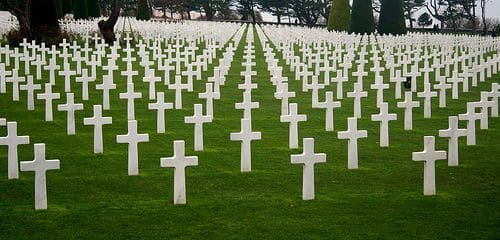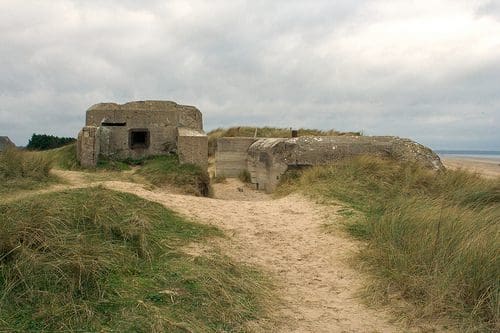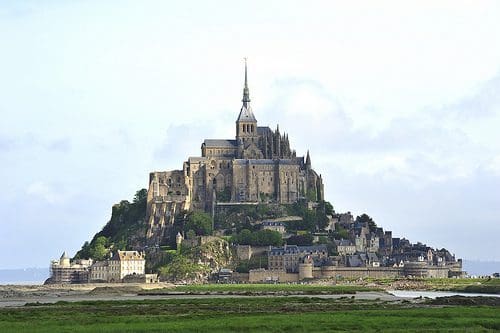
2014 is the 70th anniversary of D-Day and the allied landings in Normandy, France. Hundreds of thousands of visitors will be flocking to Normandy this summer to commemorate the historic events that launched the liberation of Europe in 1944. But World War II history is not all Normandy has to offer. Its bucolic scenery is celebrated by impressionist painters, quaint villages dot the region, and centuries of history lie ready to be retold.
Normandy World War II Memorials
Most visitors start their visit to Normandy with the World War II fortifications and landing beaches. The 170-acre American Military Cemetery in Colleville-sur-mer, part of the area code-named Omaha Beach, is a moving testament to the sacrifice and heroism displayed by the soldiers during the attack. Thousands upon thousands of white crosses extend in evenly spaced rows, marking the graves of American soldiers who died in Europe during WWII.
Millicent Ruddy, a friend of Covington Travel, escorted many students to Normandy during her years as a High School French teacher. She said when her students saw the grave markers of young men who died at 17 or 18, it became very personal and poignant to them. Even with abundant knowledge of the history and area, she recommends a guided tour to navigate the crowds and provide focus. She recounted one story to me:
“One student, at the end of the tour said, ‘My grand uncle died in the invasion but at St. Mere Eglise’ (slightly west of the American Cemetery). Knowing that after the war, some American casualties were moved, I said, ‘You know, we ought to talk to the guardian of this cemetery and see if perhaps your relative was re-interred here.’ We went to the Concierge office and he got out a huge book that looked like a copy of Gutenberg’s Bible with beautiful handwritten script. We watched as he ran is finger down the pages searching for the uncle’s name. Finally he came to it – he ran his finger across the page and proclaimed, ‘Yes, he is buried here. I will take you to his grave in my golf cart,’ which he did. It was a touching experience.”
There are several state-of-the-art museums along the coastal area that give broad WWII history lessons (Caen Memorial), as well as insight into the personal experiences of the young men who fought and died there (Merville Battery Museum). A 360° cinema in Arromanches depicts war scenes juxtaposed with images of contemporary daily life in the area. The Airborne Museum in Sainte-Mere-Eglise examines the aviation contribution to the Battle of Normandy.
This summer will be a particularly meaningful time to visit the battle sites. Travel Maestro tip: Don’t plan to visit on June 6, the actual anniversary of D-Day. Many heads of state will be there, so security and traffic will make it nearly impossible to visit the beaches and other WWII sites.

If you do visit the battle sites, one of our wonderful Virtuoso partners in France, Chocolatine, highly recommends the restaurant at the Hotel de la Marine in the historic town of Arromanches-les-Bains, overlooking the D-Day Museum and one of the most famous WWII landing beaches. Chocolatine tip: “Seafood and fresh fish are the specialty here—mussels, crab, oysters, sole, sea bream, and lobster, which literally come right from the sea to your plate!” They also suggest the charming village of Beuvron en Auge – designated one of France’s “most beautiful villages.” Florent from Chocolatine says, “I enjoyed a fantastic lunch here at le Café Forges, a bistro recently opened by the one-star-Michelin chef, Jerome Bansart, who owns the restaurant next door – Le Pave d’Auge. The Café Forges has a wonderful ambiance – it was a former iron forge – and the staff was very welcoming and the food excellent! The three-course lunch was very reasonable at 18 Euros.”
Normandy Villages
Judy Faust, Covington Travel France Specialist, shared some of her favorite Normandy villages that she has enjoyed.
Bayeux – An ancient town existed here since Celtic and Roman times and an imposing Gothic cathedral sits in the city center. The town is best known for the impressive Bayeux Tapestry, an embroidered history of the Battle of Hastings and the events that surrounded it. It’s believed to date to the mid-15th century and Judy says it’s a must-see for anyone into needlework, history or textiles. Judy’s tip: See if you can find Haley’s Comet embroidered in the front portion of the tapestry.

Villedieu-les-Poeles – a good stop for gourmets and cooks. Villedieu is known for the excellent copper pots, prized by cooks for their workmanship, even heating and beauty. They are gorgeous and HEAVY. Judy’s tip: Buy a small one, plan on shipping, or expect to pay for excessive baggage weight on the flight home!
Deauville – Since the 19th century, this Normandy village has been a posh seaside resort. It hosts France’s equivalent to Ascot, an international film festival, and political events such as the G8 Summit. Judy’s tip: Bring your credit card for deluxe shopping – Coco Chanel opened her first boutique here.

Mont St. Michel – The tidal island was a strategic fortification, topped by an abbey and monastery for over 1,000 years. During the 1700s the Mont became a prison, which was closed in 1863 and the buildings protected. In 1979 it was designated the first UNESCO World Heritage Site and today receives over 3 million visitors a year.
From the rich green pastures to the marvelous beaches, it’s no secret that Normandy offers beautiful landscapes and plenty to sightsee. There will be more people than ever visiting this historic corner of France this year, so you need to plan now if you want to visit this summer. Talk to Covington’s France Specialists for help arranging your fascinating Normandy vacation.






Leave a Reply